开源诊断利器Arthas ByteKit 深度解读(1):基本原理介绍
Arthas ByteKit 深度解读(1):基本原理介绍
前言
本文由整体到局部的思路展开分析Arthas ByteKit 字节码处理框架,结合类图和数据流图,介绍ByteKit字节码处理流程及核心对象。
简介
Arthas ByteKit 为新开发的字节码工具库,基于ASM提供更高层的字节码处理能力,面向诊断/APM领域,不是通用的字节码库。ByteKit期望能提供一套简洁的API,让开发人员可以比较轻松的完成字节码增强。
本文主要介绍以下几点:
-
ByteKit 基本用法
-
ByteKit 字节码处理流程
-
如何解析Interceptor Class
-
ByteKit 字节码核心处理逻辑
-
LocationMatcher/Location的魔力
-
@Binding原理介绍
基本概念
首先介绍ByteKit的基本概念:
-
Target class : 拦截的目标类,本文中为Sample类;
-
Interceptor class : 用户定义的拦截器类,定义了目标类的字节码增强逻辑,本文为SampleInterceptor;
-
ExceptionSuppressHandler : 拦截器使用的异常处理器,用于捕获处理拦截方法意外抛出的异常;
-
ClassNode/MethodNode : 通过Java asm 工具库将二进制的class字节码转换成的结构化对象;
基本用法
为了理解起来更加清晰,对 com.example.ByteKitDemo 进行简单修改,避免内部类造成的干扰,抽取几个独立类如下:
-
SampleDemo: 测试入口类
-
Sample: 要增强的目标类
-
SampleInterceptor: Sample类的拦截器
-
PrintExceptionSuppressHandler: 异常处理器
-
EnhanceUtil: ByteKit 处理逻辑封装
package com.example;
import com.alibaba.arthas.deps.org.objectweb.asm.tree.ClassNode;
import com.alibaba.arthas.deps.org.objectweb.asm.tree.MethodNode;
import com.taobao.arthas.bytekit.asm.MethodProcessor;
import com.taobao.arthas.bytekit.asm.binding.Binding;
import com.taobao.arthas.bytekit.asm.interceptor.InterceptorProcessor;
import com.taobao.arthas.bytekit.asm.interceptor.annotation.AtEnter;
import com.taobao.arthas.bytekit.asm.interceptor.annotation.AtExceptionExit;
import com.taobao.arthas.bytekit.asm.interceptor.annotation.AtExit;
import com.taobao.arthas.bytekit.asm.interceptor.annotation.ExceptionHandler;
import com.taobao.arthas.bytekit.asm.interceptor.parser.DefaultInterceptorClassParser;
import com.taobao.arthas.bytekit.utils.AgentUtils;
import com.taobao.arthas.bytekit.utils.AsmUtils;
import com.taobao.arthas.bytekit.utils.Decompiler;
import java.util.Arrays;
import java.util.List;
// 要拦截增强的目标类
class Sample {
private int exceptionCount = 0;
public String hello(String str, boolean exception) {
if (exception) {
exceptionCount++;
throw new RuntimeException("test exception, str: " + str);
}
return "hello " + str;
}
}
// Sample 类的拦截器
class SampleInterceptor {
// 拦截方法Entry点进行处理
@AtEnter(inline = false, suppress = RuntimeException.class, suppressHandler = PrintExceptionSuppressHandler.class)
public static void atEnter(@Binding.This Object object,
@Binding.Class Object clazz,
@Binding.Args Object[] args,
@Binding.MethodName String methodName,
@Binding.MethodDesc String methodDesc) {
System.out.println("atEnter, args[0]: " + args[0]);
}
// 拦截方法正常返回的语句,在返回前进行处理
@AtExit(inline = true)
public static void atExit(@Binding.Return Object returnObject) {
System.out.println("atExit, returnObject: " + returnObject);
}
// 拦截方法内部抛出异常点
@AtExceptionExit(inline = true, onException = RuntimeException.class)
public static void atExceptionExit(@Binding.Throwable RuntimeException ex,
@Binding.Field(name = "exceptionCount") int exceptionCount) {
System.out.println("atExceptionExit, ex: " + ex.getMessage() + ", field exceptionCount: " + exceptionCount);
}
}
// 异常处理器
class PrintExceptionSuppressHandler {
@ExceptionHandler(inline = true)
public static void onSuppress(@Binding.Throwable Throwable e, @Binding.Class Object clazz) {
System.out.println("exception handler: " + clazz);
e.printStackTrace();
}
}
// ByteKit 处理逻辑封装
class EnhanceUtil {
public static byte[] enhanceClass(Class targetClass, String[] targetMethodNames, Class interceptorClass) throws Exception {
// 初始化Instrumentation
AgentUtils.install();
// 解析定义的 Interceptor类 和相关的注解
DefaultInterceptorClassParser interceptorClassParser = new DefaultInterceptorClassParser();
List<InterceptorProcessor> processors = interceptorClassParser.parse(interceptorClass);
// 加载字节码
ClassNode classNode = AsmUtils.loadClass(targetClass);
List<String> methodNameList = Arrays.asList(targetMethodNames);
// 对加载到的字节码做增强处理
for (MethodNode methodNode : classNode.methods) {
if (methodNameList.contains(methodNode.name)) {
MethodProcessor methodProcessor = new MethodProcessor(classNode, methodNode);
for (InterceptorProcessor interceptor : processors) {
interceptor.process(methodProcessor);
}
}
}
// 获取增强后的字节码
return AsmUtils.toBytes(classNode);
}
}
//测试入口类
class SampleDemo {
public static void main(String[] args) throws Exception {
// 启动Sample
System.out.println("before retransform ...");
try {
Sample sample = new Sample();
sample.hello("1", false);
sample.hello("2", true);
} catch (Exception e) {
e.printStackTrace(System.out);
}
System.out.println();
// 对Sample类的hello方法进行拦截处理,返回增强后的字节码
byte[] bytes = EnhanceUtil.enhanceClass(Sample.class, new String[]{"hello"}, SampleInterceptor.class);
// 查看反编译结果
//System.out.println(Decompiler.decompile(bytes));
// 通过 reTransform 增强类
AgentUtils.reTransform(Sample.class, bytes);
// 启动Sample
System.out.println("after retransform ...");
try {
Sample sample = new Sample();
sample.hello("3", false);
sample.hello("4", true);
} catch (Exception e) {
e.printStackTrace(System.out);
}
}
}
SampleInterceptor 拦截器类解析
// Sample 类的拦截器
class SampleInterceptor {
// 拦截方法Entry点进行处理
@AtEnter(inline = false, suppress = RuntimeException.class, suppressHandler = PrintExceptionSuppressHandler.class)
public static void atEnter(@Binding.This Object object,
@Binding.Class Object clazz,
@Binding.Args Object[] args,
@Binding.MethodName String methodName,
@Binding.MethodDesc String methodDesc) {
System.out.println("atEnter, args[0]: " + args[0]);
}
// 拦截方法正常返回的语句,在返回前进行处理
@AtExit(inline = true)
public static void atExit(@Binding.Return Object returnObject) {
System.out.println("atExit, returnObject: " + returnObject);
}
// 拦截方法内部抛出异常点
@AtExceptionExit(inline = true, onException = RuntimeException.class)
public static void atExceptionExit(@Binding.Throwable RuntimeException ex,
@Binding.Field(name = "exceptionCount") int exceptionCount) {
System.out.println("atExceptionExit, ex: " + ex.getMessage() + ", field exceptionCount: " + exceptionCount);
}
}
-
@AtEnter @AtExit @AtExceptionExit
-
用
@Binding.Xxx注解绑定了不同的参数; -
@AtEnter inline = false SampleInterceptor.atEnter()
-
@AtExit inline = true SampleInterceptor.atExit()
-
@AtEnter suppress = RuntimeException.class suppressHandler = PrintExceptionSuppressHandler.class try/catch
-
@AtExceptionExit在原方法体范围try-catch 指定异常进行处理。
@ExceptionHandler 解析:
在上面的 @AtEnter 配置里,生成的代码会被 try/catch 包围,那么具体的内容是在 PrintExceptionSuppressHandler 里。
将增强后的字节码反编译得到的代码如下,为方便理解加上注释:
public String hello(String str, boolean exception) {
// @AtEnter 原方法体之前插入拦截代码:inline=false 调用拦截方法SampleInterceptor.atEnter()
try {
SampleInterceptor.atEnter(this, Sample.class, new Object[]{str, new Boolean(exception)}, "hello", "(Ljava/lang/String;Z)Ljava/lang/String;");
} catch (RuntimeException var11) { // suppress 在拦截方法后插入try-catch指定异常
// inline 展开suppressHandler (PrintExceptionSuppressHandler.class)
Class var6 = Sample.class;
System.out.println("exception handler: " + var6);
var11.printStackTrace();
}
try {
// 原hello方法处理逻辑
if (exception) {// 66
++this.exceptionCount;// 67
throw new RuntimeException("test exception, str: " + str);// 68
} else {
String var3 = "hello " + str;// 70
// @AtExit return语句前插入inline 展开SampleInterceptor.atExit()方法内容
System.out.println("atExit, returnObject: " + var3);
// 原hello方法的return语句
return var3;
}
} catch (RuntimeException var10) { // @AtExceptionExit 在原方法体范围try-catch指定异常
// inline 展开SampleInterceptor.atExceptionExit()方法内容
int var9 = this.exceptionCount;
System.out.println("atExceptionExit, ex: " + var10.getMessage() + ", field exceptionCount: " + var9);
throw var10;
}
}
字节码处理流程
asm字节码处理流程:
目标类 class bytes -> ClassReader解析 -> ClassVisitor增强修改字节码 -> ClassWriter生成增强后的 class bytes -> 通过Instrumentation解析加载为新的Class.
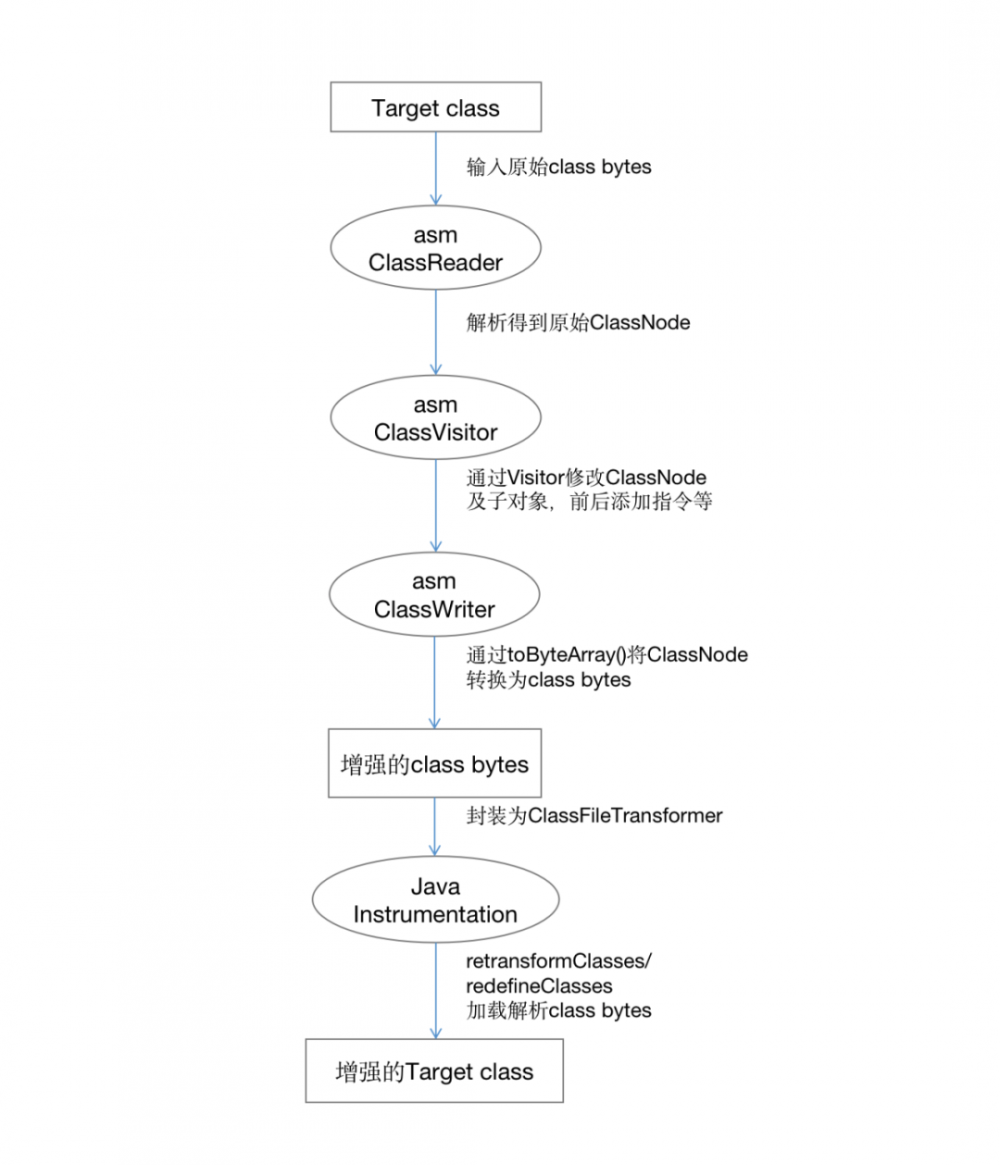
ByteKit 字节码处理流程:
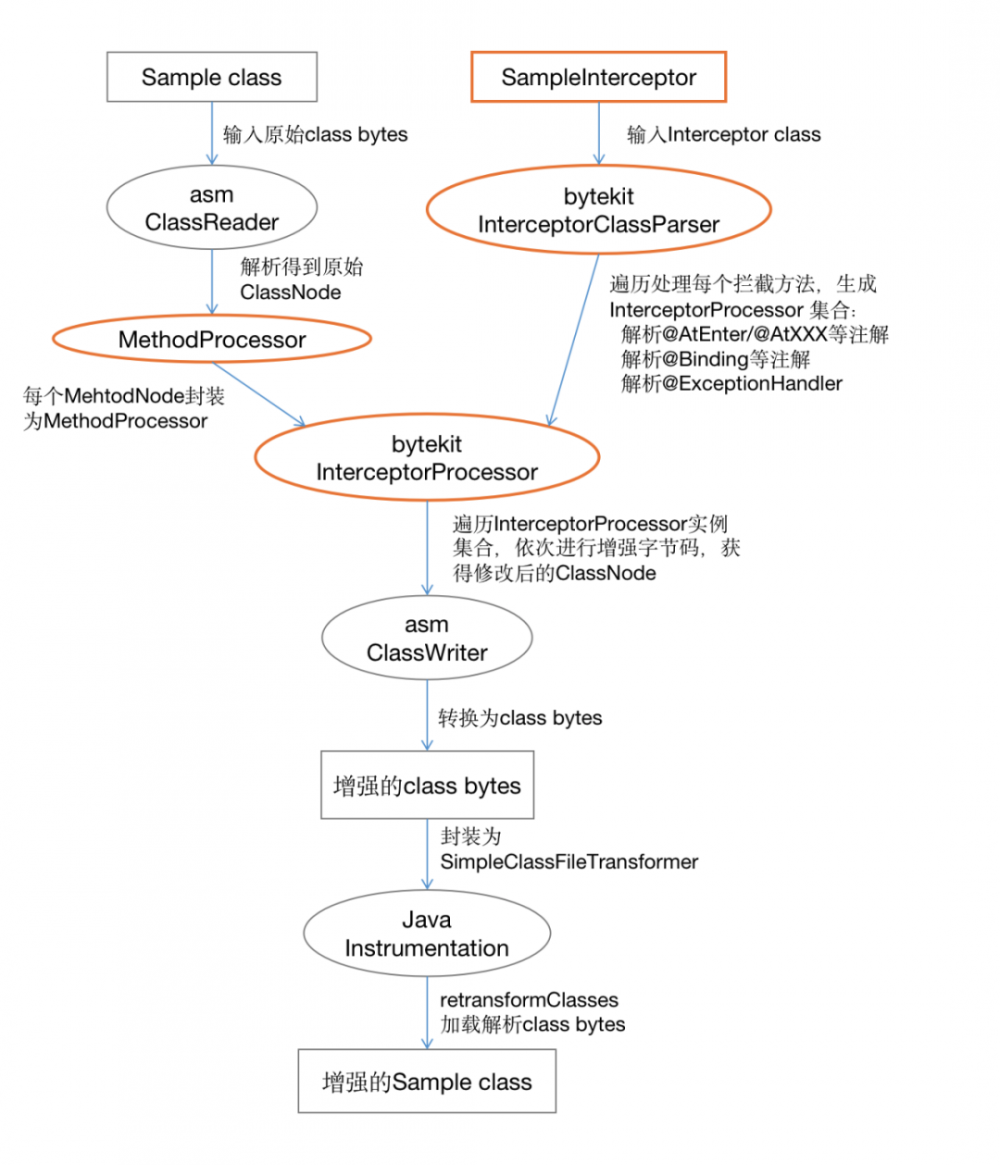
ByteKit对比asm的改进:
-
用户只需要定义Interceptor class 及 Exception handler class,ByteKit自动将拦截方法的代码以字节码形式织入目标类,替代asm的ClassVisitor字节码指令相关处理;
-
Interceptor class 及 Exception handler class 完全是Java语法,不需要编写任何Java 字节码指令代码,大幅降低使用门槛;
-
Interceptor class 支持非常丰富的
@AtXxx代码拦截点,除了常见的方法进入/退出/异常拦截点外,还包括行号/调用方法/访问字段/同步块等 -
支持丰富的
@Binding参数绑定,如this对象/Class/返回值/方法入参/局部变量/字段/调用方法的名称/调用方法的参数/行号等 -
支持inline方式将拦截器的代码内联到目标方法中
-
invokeOrigin技术,在原方法前后插入代码,直接使用原方法的参数及局部变量!
其它特性,详细内容可以参考ByteKit文档。
从ByteKit的样例代码及上面的处理流程图,我们得知Interceptor class 是最为关键的信息,包含了用户定义的拦截处理逻辑。ByteKit 需要将Interceptor class 转换为程序可以使用的描述性数据结构,然后根据这些描述数据修改目标类的字节码。ByteKit的主要处理步骤:
-
解析Interceptor Class的
@AtXxx,@Binding等注解,生成InterceptorProcessor对象集合; -
遍历InterceptorProcessor集合,修改原方法的字节码;
ByteKit 核心类图
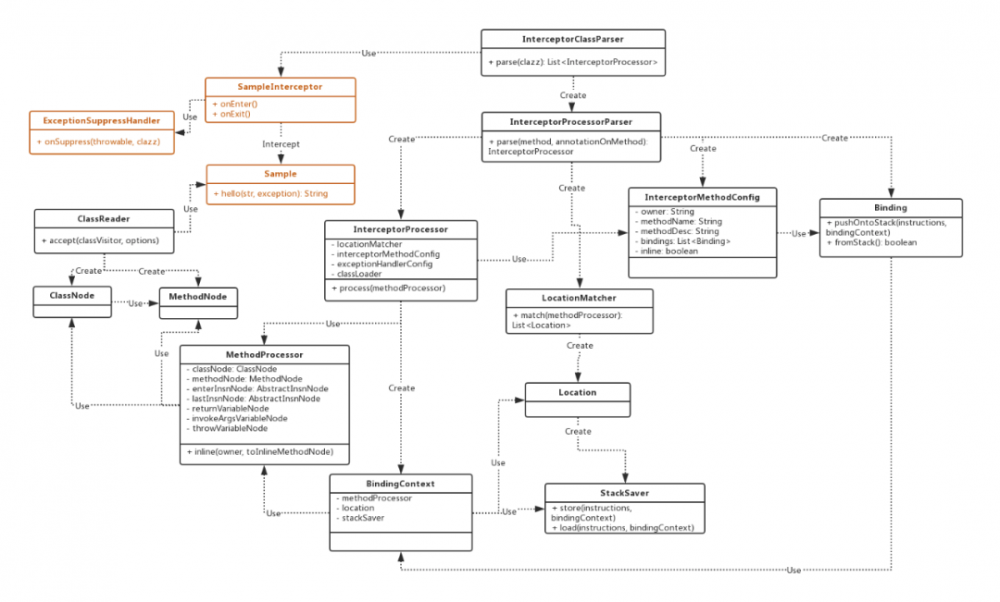
橙色的3个类是用户定义的Target类和拦截器,上面已经进行说明。这里列举一下ByteKit核心类及其作用:
-
InterceptorClassParser DefaultInterceptorClassParser @AtXxx InterceptorProcessorParser
-
InterceptorProcessorParser @AtXxx InterceptorProcessor LocationMatcher InterceptorMethodConfig Binding
-
InterceptorProcessor: 拦截器字节码处理类,也是用户定义的拦截方法的解析结果,每一个拦截方法生成一个InterceptorProcessor实例; -
MethodProcessor: Target方法处理类,包含原始方法的ClassNode和MethodNode; -
InterceptorMethodConfig: 拦截方法的VO类,记录了方法签名及其Binding等信息; -
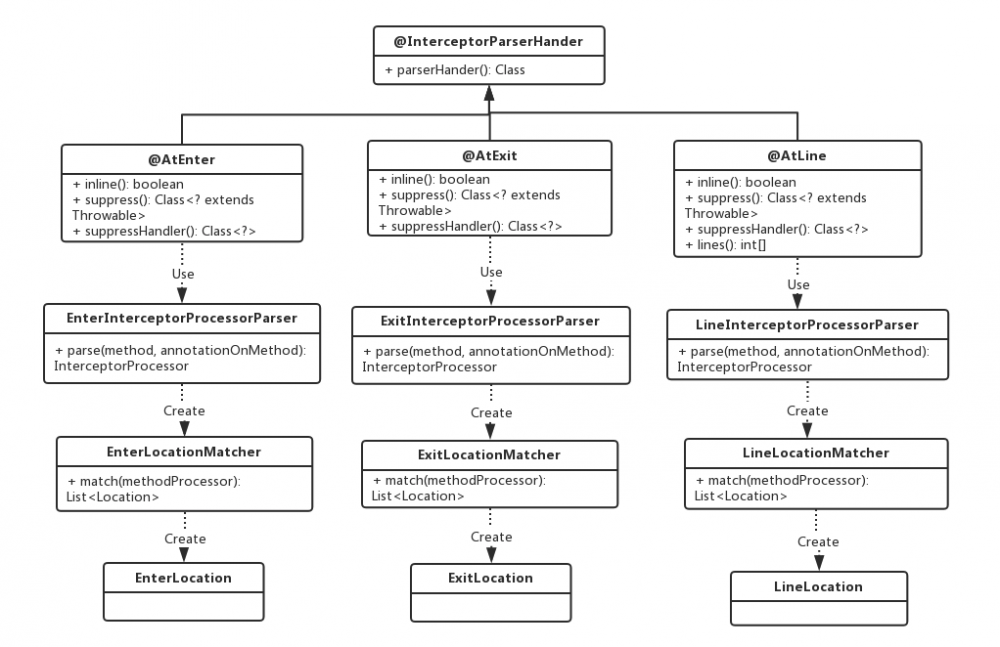
-
@AtXxx: 拦截点注解,标记在拦截方法上; -
LocationMatcher Location @AtXxx LocationMatcher
-
Location @AtXxx Location
-
StackSaver: 将栈数据保存到隐藏变量或者从隐藏局部变量加载到栈上。 -
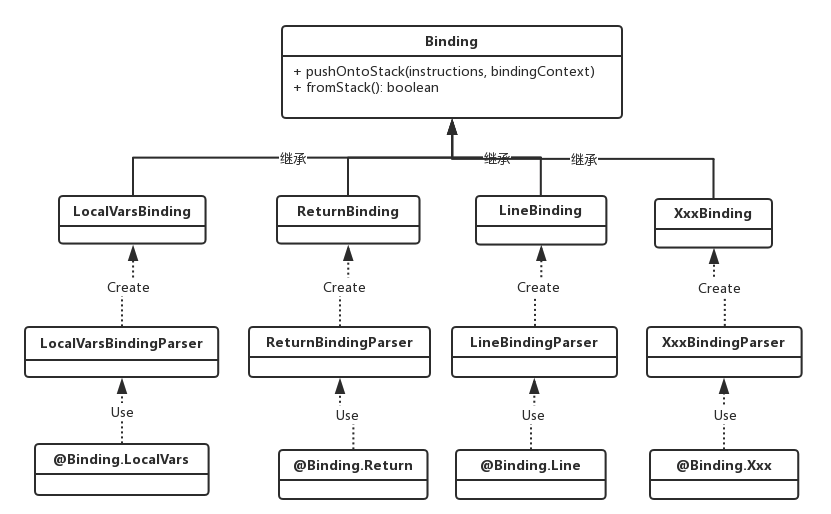
-
@Binding.Xxx: 拦截方法的参数绑定注解,按用户定义的参数顺序准备相应的数据到栈上; -
XxxBindingParser:@Binding.Xxx注解的解析类,生成对应的Binding子类; -
Binding: @Binding.Xxx 绑定注解的字节码处理类,每个@Binding.Xxx有一个对应的Binding子类,负责@Binding.Xxx 参数的栈数据处理逻辑;
解析Interceptor Class
遍历Interceptor 的静态方法,解析每个方法上的 @AtXxx 注解和@Binding.Xxx注解,生成InterceptorProcessor对象。
public class DefaultInterceptorClassParser implements InterceptorClassParser {
public List<InterceptorProcessor> parse(Class<?> clazz) {
final List<InterceptorProcessor> result = new ArrayList<InterceptorProcessor>();
// 拦截方法回调处理函数
MethodCallback methodCallback = new MethodCallback() {
@Override
public void doWith(Method method) throws IllegalArgumentException, IllegalAccessException {
// 枚举拦截方法标记的所有Annatation注解
for (Annotation onMethodAnnotation : method.getAnnotations()) {
for (Annotation onAnnotation : onMethodAnnotation.annotationType().getAnnotations()) {
// 找到InterceptorParserHander的子类,即@AtXxx注解
if (InterceptorParserHander.class.isAssignableFrom(onAnnotation.annotationType())) {
// 判断是否为静态方法
if (!Modifier.isStatic(method.getModifiers())) {
throw new IllegalArgumentException("method must be static. method: " + method);
}
// 找到@AtXxx注解指定的parserHander类并实例化
InterceptorParserHander handler = (InterceptorParserHander) onAnnotation;
InterceptorProcessorParser interceptorProcessorParser = InstanceUtils
.newInstance(handler.parserHander());
// 调用InterceptorProcessorParser.parse()解析拦截方法生成InterceptorProcessor对象
InterceptorProcessor interceptorProcessor = interceptorProcessorParser.parse(method,
onMethodAnnotation);
result.add(interceptorProcessor);
}
}
}
}
};
//枚举拦截器的所有方法
ReflectionUtils.doWithMethods(clazz, methodCallback);
return result;
}
}
结合下面的@AtEnter注解进行理解:
@Documented
@Retention(RetentionPolicy.RUNTIME)
@java.lang.annotation.Target(ElementType.METHOD)
// parserHander属性指定本注解的Parser类为EnterInterceptorProcessorParser.class
@InterceptorParserHander(parserHander = EnterInterceptorProcessorParser.class)
public @interface AtEnter {
boolean inline() default true;
Class<? extends Throwable> suppress() default None.class;
Class<?> suppressHandler() default Void.class;
class EnterInterceptorProcessorParser implements InterceptorProcessorParser {
@Override
public InterceptorProcessor parse(Method method, Annotation annotationOnMethod) {
// 创建本注解的LocationMatcher实例:EnterLocationMatcher
LocationMatcher locationMatcher = new EnterLocationMatcher();
// 创建 InterceptorProcessor
AtEnter atEnter = (AtEnter) annotationOnMethod;
return InterceptorParserUtils.createInterceptorProcessor(method,
locationMatcher,
atEnter.inline(),
atEnter.suppress(),
atEnter.suppressHandler());
}
}
}
@Binding.Xxx解析过程与 @AtXxx 注解类似,这里不再展开说明。
核心处理逻辑
上一小节主要讲解Interceptor class的解析过程,本小节主要是讲解ByteKit怎么实现字节码增强的核心逻辑。 InterceptorProcessor.process() 的字节码处理核心逻辑如下:
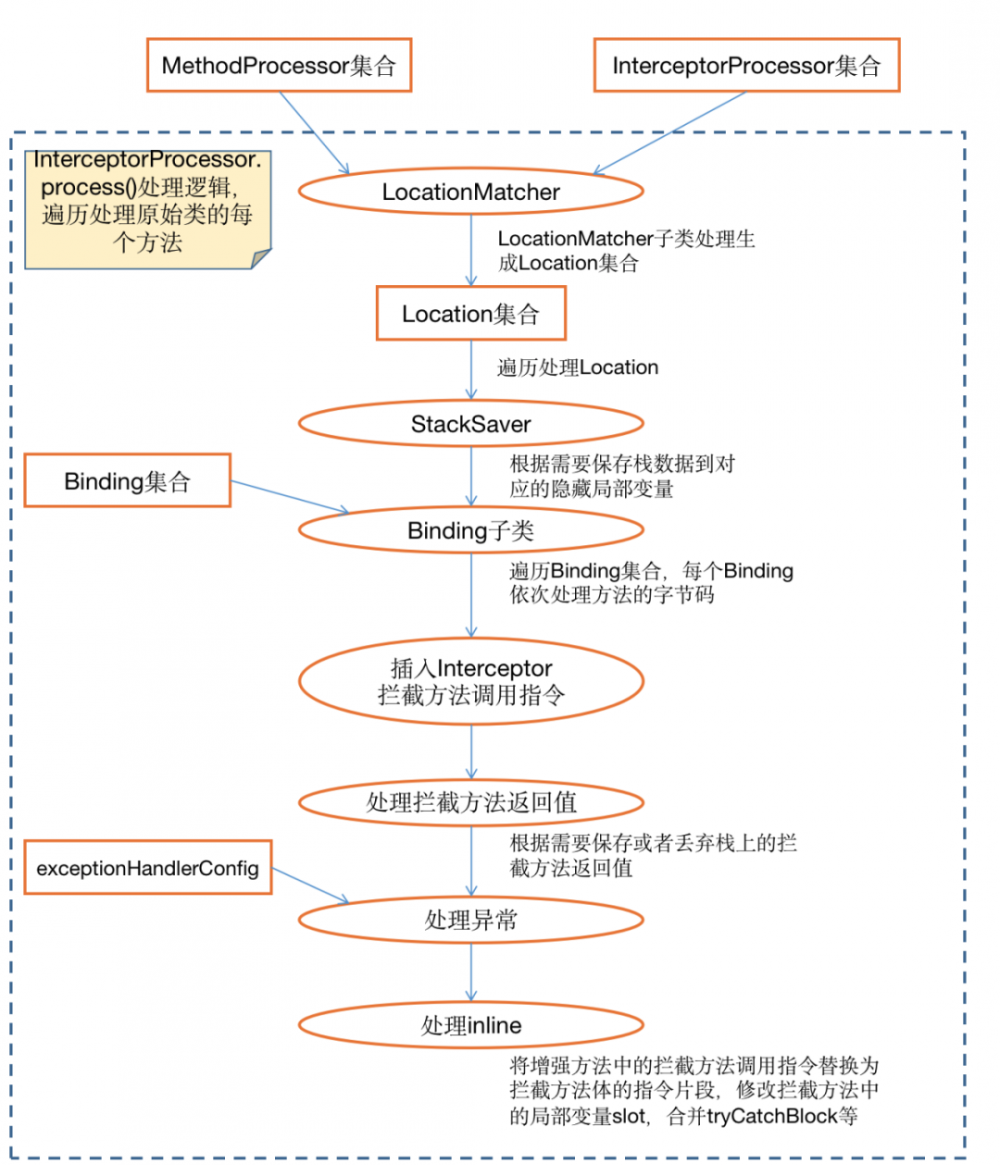
此方法为最主要的字节码处理逻辑,这里涉及到ByteKit核心的几个字节码处理类:
-
MethodProcessor 实例是原始方法封装对象,可以理解为原材料;
-
各种LocationMatcher、Binding子类可以理解为各种配件;
-
InterceptorProcessor 实例可以理解为某个拦截方法的套件工具,对MethodProcessor进行处理后即完成了这个拦截方法的字节码增强;
每个InterceptorProcessor实例的处理过程:
-
通过LocationMatcher计算得到Location集合;
-
遍历Location集合进行处理;
-
根据需要使用StackSaver保存当前栈数据到隐藏变量,某些Binding会从隐藏变量加载数据;
-
遍历处理Binding集合,本拦截方法的每个@Binding.Xxx参数都需要依次处理;
-
插入拦截方法调用指令,如SampleInterceptor.atEnter();
-
根据需要处理拦截方法的返回值,支持使用拦截方法返回值替换修改原方法return值或者丢弃多余的拦截方法返回值;
-
拦截方法的supress异常处理;
-
如果拦截方法注解配置
inline=true,则展开拦截方法的内容,替换掉前面(5)插入的拦截方法调用指令; -
处理下一个Location;
LocationMatcher/Location 的魔力
学习ByteKit框架时,一直有一个问题困扰着我:
LocationMatcher/Location 这个是什么?与 @AtXxx 注解有什么关系?
单从字面理解LocationMatcher/Location有困难,那么我们顺着ByteKit处理字节码的思路来推导一下。
ByteKit 处理流程与传统asm ClassVisitor不同:
-
ClassVisitor是在遍历原始方法指令时修改插入新增的指令;
-
ByteKit是遍历Interceptor拦截方法,将每个拦截方法的增强逻辑应用于原始方法上;
两者指令定位的差异:
-
ClassVisitor在visitXxx方法中进行判断是否遇到期望的指令,如方法调用指令、return指令等;
-
ByteKit也需要定位每个拦截方法的开始指令,这个就是通过LocationMatcher来实现;
ByteKit 指令定位过程
1.解析Interceptor class生成定位规则
-
预处理解析Interceptor class时,没有Target class的信息,不可能产生Target class相关的字节码数据,所以此时ByteKit 生成了LocationMatcher实例和Binding实例。Binding是参数绑定的规则,LocationMatcher则是指令定位规则。
-
不同的拦截注解
@AtXxx的定位规则不同,所以会有对应的LocationMatcher子类;
2.通过定位规则计算定位点
-
LocationMatcher 对MethodProcessor实例计算处理后,生成Location实例集合。Location 即指令定位点,记录了当前拦截方法指令处理的
开始指令。 -
这里体现了asm指令列表InsnList的双向链表的妙处,通过某个指令可以很方便地前或者往后遍历或者插入新的指令,即使这个指令前后多次修改插入其它指令,仍然可以正确定位!
问题答案:LocationMatcher 为拦截方法 @AtXxx 注解的定位规则,Location 为具体的指令定位点。
LocationMatcher分析
1.EnterLocationMatcher 将原始方法体开始的第一条有效指令enterInsnNode封装为EnterLocation。
public class EnterLocationMatcher implements LocationMatcher {
@Override
public List<Location> match(MethodProcessor methodProcessor) {
List<Location> locations = new ArrayList<Location>();
AbstractInsnNode enterInsnNode = methodProcessor.getEnterInsnNode();
LocationFilter locationFilter = methodProcessor.getLocationFilter();
if (locationFilter.allow(enterInsnNode, LocationType.ENTER, true)) {
EnterLocation enterLocation = new EnterLocation(enterInsnNode);
locations.add(enterLocation);
}
return locations;
}
}
2.ExitLocationMatcher
一个LocationMatcher可能计算产生多个Location实例,比如@AtExit的ExitLocationMatcher 会查找到原始方法中所有return指令,为每个return指令生成一个ExitLocation。
public class ExitLocationMatcher implements LocationMatcher {
@Override
public List<Location> match(MethodProcessor methodProcessor) {
List<Location> locations = new ArrayList<Location>();
AbstractInsnNode insnNode = methodProcessor.getEnterInsnNode();
while (insnNode != null) {
if (insnNode instanceof InsnNode) {
InsnNode node = (InsnNode) insnNode;
// 判断是否某种return指令
if (matchExit(node)) {
LocationFilter locationFilter = methodProcessor.getLocationFilter();
// 检查是否为允许的Location,主要是防止重复增强字节码
if (locationFilter.allow(node, LocationType.EXIT, false)) {
// 创建Location
ExitLocation ExitLocation = new ExitLocation(node);
locations.add(ExitLocation);
}
}
}
insnNode = insnNode.getNext();
}
return locations;
}
public boolean matchExit(InsnNode node) {
switch (node.getOpcode()) {
case Opcodes.RETURN: // empty stack
case Opcodes.IRETURN: // 1 before n/a after
case Opcodes.FRETURN: // 1 before n/a after
case Opcodes.ARETURN: // 1 before n/a after
case Opcodes.LRETURN: // 2 before n/a after
case Opcodes.DRETURN: // 2 before n/a after
return true;
}
return false;
}
}
@Binding 原理介绍
SampleInterceptor中通过 @Binding.MethodName String methodName 绑定了方法名参数,在运行时这个methodName参数就真的被填充了数据,我们来看一下到底是怎么实现这个呢?
public class MethodNameBinding extends Binding {
@Override
public void pushOntoStack(InsnList instructions, BindingContext bindingContext) {
MethodProcessor methodProcessor = bindingContext.getMethodProcessor();
AsmOpUtils.ldc(instructions, methodProcessor.getMethodNode().name);
}
@Override
public Type getType(BindingContext bindingContext) {
return Type.getType(String.class);
}
}
这个 MethodNameBinding 实现逻辑挺简单的,插入一条 ldc method_name 指令就搞定了。
反编译的代码,第4个参数"hello"即是方法名称:
SampleInterceptor.atEnter(this, Sample.class, new Object[]{str, new Boolean(exception)}, "hello", "(Ljava/lang/String;Z)Ljava/lang/String;");
javap -v 查看字节码:
23: ldc #25 // String hello 25: ldc #26 // String (Ljava/lang/String;Z)Ljava/lang/String; 27: invokestatic #32 // Method com/example/SampleInterceptor.atEnter:(Ljava/lang/Object;Ljava/lang/Object;[Ljava/lang/Object;Ljava/lang/String;Ljava/lang/String;)V
这里涉及到方法调用指令 invokestatic 的使用方法:
Description: calls a static method
n is the number of arguments to the method
the long method name is really a path name, the name of the class, the parenthesized argument list of the method called, and the return type.
Primitive types are represented by their capitalized first letter, ie I for an integer.
()V
Stack
| Before | After |
|---|---|
| arg n | returned value |
| ... | |
| arg 1 |
invokestatic 用于调用静态方法,将方法的参数从左至右依次压入栈,调用静态方法时将全部参数弹出栈,然后将方法的返回值重新放入栈顶。
第23行 ldc #25 // String hello 的作用是加载常量表 Constant pool 中的 #25 常量压入栈,这个常量就是字符串"hello"。下面是常量表:
Constant pool: #1 = Utf8 com/example/Sample #2 = Class #1 // com/example/Sample ... #16 = Utf8 hello #17 = Utf8 (Ljava/lang/String;Z)Ljava/lang/String; ... #25 = String #16 // hello #26 = String #17 // (Ljava/lang/String;Z)Ljava/lang/String;
简单来说,在调用 SampleInterceptor.atEnter 拦截方法前,需要将它的参数依次入栈,调用拦截方法前的参数准备工作由Binding类完成,即 Binding的作用就是将绑定参数的值依序放入栈中 。
下面介绍几种不同类型的参数绑定处理方式:
-
@Binding.MethodName String methodName这个绑定参数方法名为常量值,直接从常量表加载入栈即可。 -
@Binding.Args Object[] args这个绑定参数为拦截的目标方法的调用参数,则需要从方法的局部变量表LocalVariableTable中加载,并构造一个Object[]数组对象入栈,具体实现逻辑请查看《Arthas ByteKit 深度解读(2):本地变量及参数绑定》。 -
@Binding.InvokeArgs Object[] invokeArgs这个绑定参数为目标方法中调用其它方法的参数列表,绑定的处理更加复杂,需要创建StackSaver处理栈数据保存及恢复。大概的处理流程:在调用某个方法前将当前栈数据保存起来,然后调用拦截方法,拦截方法返回之后需要恢复栈数据,最后调用原来的方法。
总结
本文介绍了Arthas ByteKit字节码框架的基本原理,通过Interceptor class/ @AtXxx 注解/ @Binding.Xxx 注解等组件简化了Java class字节码增强的编码逻辑,不需要编写Java字节码级别的处理代码,大幅降低使用门槛。各种组件职责清晰,搭配使用灵活性高,可以满足类似APM/Spy诊断等场景下的应用需要。
- 本文标签: example constant Agent 测试 description 注释 value 同步 处理器 静态方法 编译 tar 代码 实例 开源 message 字节码 web API Document 总结 配件 ArrayList ssh https IDE parse final ACE id java struct 数据 遍历 http MQ ip UI 解析 开发 src IO node 配置 CTO 参数 lib ORM 类图 tab cat CEO list
- 版权声明: 本文为互联网转载文章,出处已在文章中说明(部分除外)。如果侵权,请联系本站长删除,谢谢。
- 本文海报: 生成海报一 生成海报二











![[HBLOG]公众号](https://www.liuhaihua.cn/img/qrcode_gzh.jpg)

